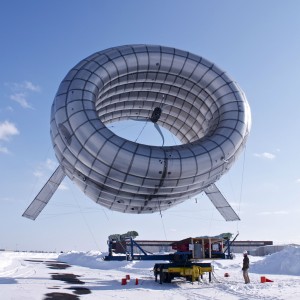
Altaeros Energies, a company based out of Alaska, has engineered the Buoyant Airborne Turbine (BAT), an inflatable shell that can carry a wind turbine thousands of feet in the air and therefore harness five to eight times more energy than a standard ground wind turbine could. The BAT can receive energy from winds reaching 45 mph and conducts power through its tough tether cables that secure it to the ground. Because of the relatively easy set-up, the BAT is intended to provide electricity, telecommunication services and Internet to remote areas and disaster-relief communities.
In reducing our nation’s emission rates and reliance on fossil fuel, wind power is emerging as the most efficient and cleanest method, even more than natural gas. According to the U.S. Energy Information Administration, wind energy is expected to make up 4.6 percent of the U.S.’s energy output by 2015. Wind energy, at this rate, could provide electric power to over 23 million homes. The U.S. Department of Energy has created and shared a new interface on its website, which tracks the development of wind farms across the country and explicates their individual potential to deliver cleaner and more energy to homes within their areas.
The American Wind Energy Association (AWEA) has reported that because of wind power, the U.S. has significantly reduced its carbon footprint this past year by 4.4 percent, or 95.6 million metric tons of CO2. President Obama’s Climate Change Agenda set expectations for the U.S. to decrease emissions by 17 percent by 2020, and it looks as though wind-generated energy could help make reaching that goal a possibility.
From 2005 to 2012, the U.S. reduced its emissions of greenhouse gasses by 12 percent, and this trend was largely seen as the consequence of the U.S.’s movement toward natural gas instead of burning coal. Energy generated from natural gas made up 30 percent of the U.S.’s total output last year. However, because of a growing market demand for renewables, if natural gas prices continue to rise, power plants may make a switch back to coal. Also, although burning natural gas emits about half the amount of CO2 that burning coal does, the methane released from natural gas sources during fracking contributes to climate change and is harmful to the surrounding environments of natural gas wells.
Wind generation is proving to be the most effective and cleanest way to channel renewable energy. For example, wind farms and turbines do not waste water like thermal power plants do, which boil large pools of water to heat their reactions and then cool down those reactors with more water. According to AWEA, by switching to wind power, the U.S. has avoided wasting 36.5 billion gallons of water last year.
With the possibilities of production tax credit and the new standards being developed by the EPA for emissions by existing power plants in the U.S., the incentives for constructing wind farms are increasing. Because of their performance in lessening the U.S.’s carbon footprint, wind farms could contribute to radically different standards in the search for cleaner and more efficient methods of providing renewable energy.






